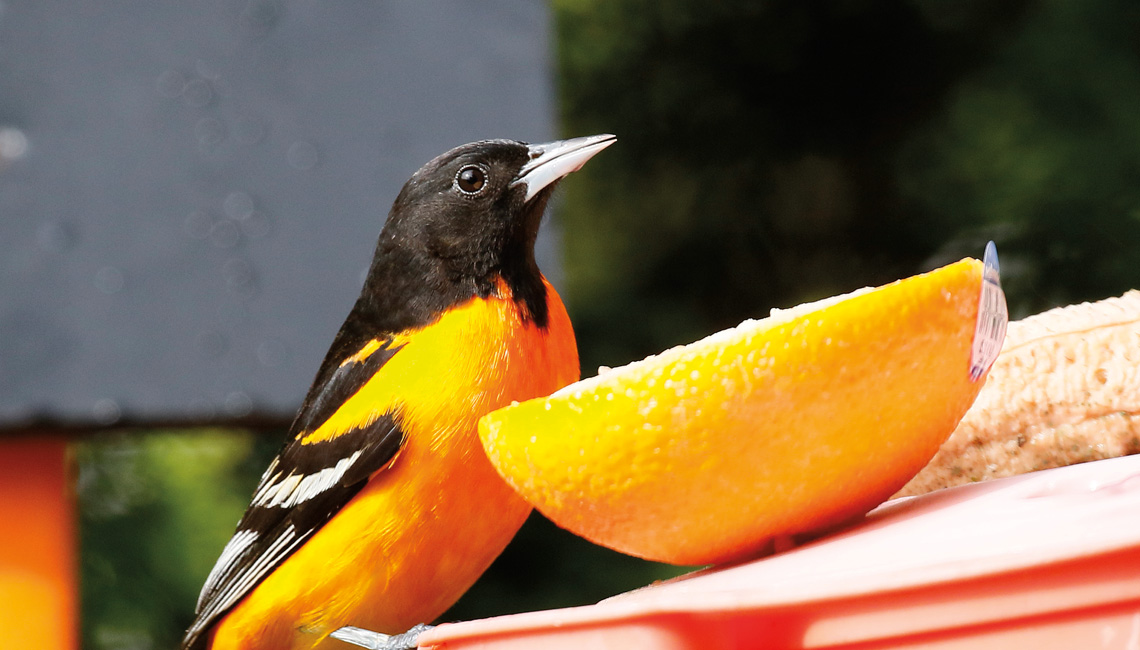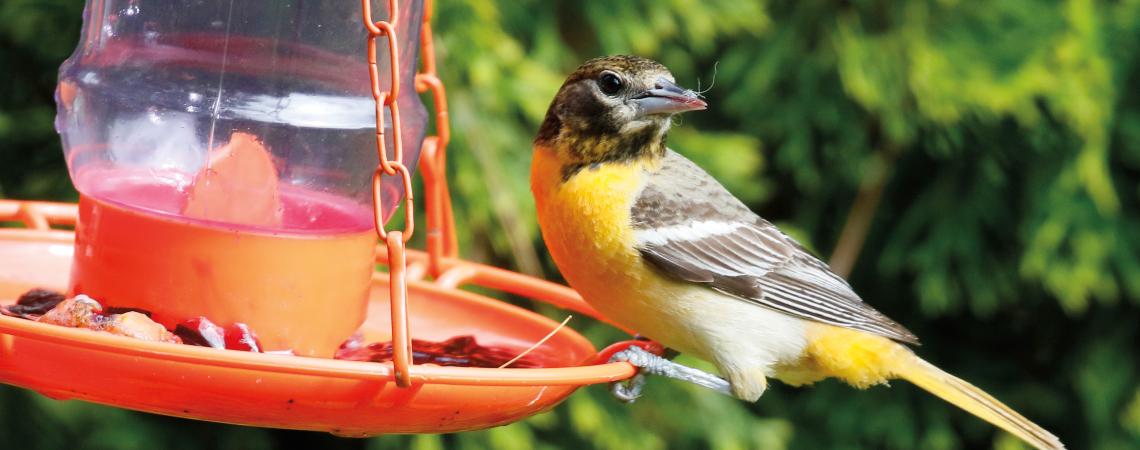Roman Mast’s backyard looks like a bird-feeding test kitchen. Mast, a member of The Energy Cooperative in Newark, maintains a dozen or more birdfeeders year-round, offering not only black-oil sunflower seed and beef suet — as most of us bird enthusiasts do — but also raw peanuts that he obtains as floor sweepings from a peanut butter factory.
But come May, he’s all about attracting orioles — of which Ohio sees two species during spring migration: the Baltimore oriole and the orchard oriole.
Baltimore orioles, such as the adult male on the left and the juvenile at right, migrate through Ohio beginning in late April and early May each year.
“I have my oriole feeders out by the last week in April,” Mast says. “Through the years, I’ve tried a lot of different foods to attract orioles, including sliced oranges, but my main food now is simply grape jelly.” Orioles and a few other species, such as rose-breasted grosbeaks, gray catbirds, and some warblers, seem to love the stuff. “A red-bellied woodpecker even comes to my jelly feeders occasionally,” Mast says.
To be successful attracting orioles, Mast says, a person must have a passion for feeding birds in general. “Whatever foods you offer must be present consistently,” he said. “You can’t have feeders empty for days and expect to attract many birds. With orioles that’s especially true; I fill my jelly feeders daily.”
Hang oriole feeders 4 to 5 feet off the ground and close to mature trees in semi-open areas. My property is surrounded by woods, so I place one feeder along the edge of the yard and a second at the edge of my back deck; both are frequented by orioles.
Patience is also required. Mast says that if you have never attempted to attract orioles previously, it may take days, or possibly even weeks, for the birds to find your feeders. To help them locate feeders, make sure they are orange in color. Mast also believes that older birds remember where they found food in the past, so they will come looking for your feeders during subsequent migrations — success building upon success year after year.
Most of the orioles passing through Ohio during spring are headed to Canada to nest, migrating from northern South America and Central America (the males arrive first). Some orioles nest in the Buckeye State as well, with Baltimore orioles weaving a uniquely shaped hanging nest that looks something like a shaggy softball tethered to a high tree limb. The nests are easier to see once leaves have fallen from the trees in autumn.
Mast takes his oriole feeders down toward the end of June, thoroughly cleans them, then stores them away until next spring. “It’s with a bit of reluctance,” he admits. “Wild birds are a serious hobby of mine, a passion, and when that particular part of the annual migration cycle winds down and eventually ends, it’s always with a touch of sadness.”
Asked about his most memorable oriole experience, Mast recounted a likely once-in-a-lifetime event that occurred in the spring of 2020. “It was during the first week of May, and the weather had turned suddenly cold with a little snow,” he says. “Natural food for orioles, such as insects, was almost nonexistent for a few days, and as a result, birds were mobbing my feeders. I counted more than 30 orioles in the bushes and trees in my backyard simultaneously — an absolutely stunning, colorful sight I’ll never forget.”
Email Chip Gross with outdoors-related questions at whchipgross@gmail.com with “Ask Chip” in the subject of the email. Your question may be answered on www.ohiocoopliving.com.
What's in a name?
The Baltimore oriole, the state bird of Maryland, takes its name from the state’s founder, Cecil, Lord Baltimore, whose family’s coat of arms was a vibrant black and orange. Orchard orioles are so named because they frequent and prefer nesting in orchards. By the way, if you have an older bird ID field guide, you might see a bird listed as a northern oriole. Baltimore and Bullock’s orioles were once lumped together as northern orioles, but recent DNA testing has since proven the birds are indeed separate species.










